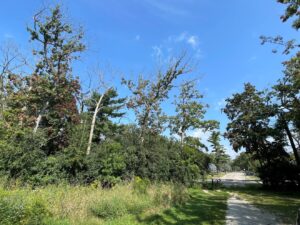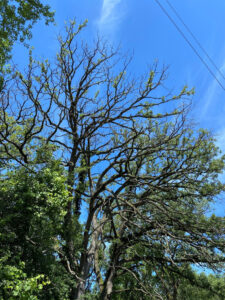
Oak decline and mortality at Big Foot Beach State Park in 2024. / Photo Credit: Wisconsin DNR
By Michael Hillstrom, DNR Forest Health Specialist
Michael.Hillstrom@wisconsin.gov
Oak decline and mortality continue to be an issue in Wisconsin, and because of the recent droughts and spongy moth outbreak, we expect these impacts to become more widespread this summer.
Forest decline is the progressive loss of tree and stand vigor and health over several years without obvious evidence of a single causal factor. Typically, trees die in a scattered fashion across a large area over several years. The additional stress from defoliation can result in pockets of heavy oak mortality, particularly on dry, sandy sites and steep, rocky ridges and hills.
Diagnosing the factors involved is the first step toward determining a management strategy.
Factors contributing to oak decline:
- Weather stressors including drought, flooding, frost and storm damage
- Tree age and density
- Soil type
- Land use history, including grazing or events that caused soil compaction
- Insects: wood borers such as twolined chestnut borer and defoliators such as spongy moth and oak leafroller
- Diseases: oak wilt, bur oak blight, Armillaria, phytophthora, wood rot fungi

A declining oak near Whitewater Lake in the Kettle Moraine State Forest – Southern Unit in Walworth County in July 2024. / Photo Credit: Bill McNee, Wisconsin DNR
Management of oak decline in forests will depend on the severity of the decline and the goals for the stand. In most cases, weak or suppressed trees die while healthy trees survive. Decline events will end on their own, but the stressors that lead to tree decline and mortality may persist for years. Therefore, it is recommended to postpone harvesting for a few years after major events such as severe drought, heavy defoliation etc., to allow stressed trees to recover. Defoliated trees may linger for 1-3 years and then die, so it is important to monitor recently defoliated stands to properly time any salvage harvesting.
Consult your region’s DNR forest health specialist for advice on how long to wait. When trees are recovered, continue sound forest management practices, such as thinning, to keep stands resilient to future stress events. If salvage harvesting is needed, avoid areas of the stand without decline and consider harvesting on frozen ground.
For high-value park or yard trees, watering and mulching are the easiest options to keep trees healthy and resilient. Hiring a certified arborist to treat trees with a fungicide and/or insecticide may also be considered but depending on the amount of decline and what stressors are impacting the tree, this option may or may not be effective.
It is recommended that property owners test for oak wilt, bur oak blight, or other diseases when these are suspected, and get a diagnosis before deciding on a management strategy. Check for galleries of twolined chestnut borer in declining branches and search trees for spongy moth egg masses and insect defoliation. Consider foliage and soil nutrient testing to determine if any nutrients are lacking before proceeding with applying nutrients.
Once you know what set of biotic, abiotic and site factors you are dealing with, you can then make an informed plan to return the forest to full productivity.
